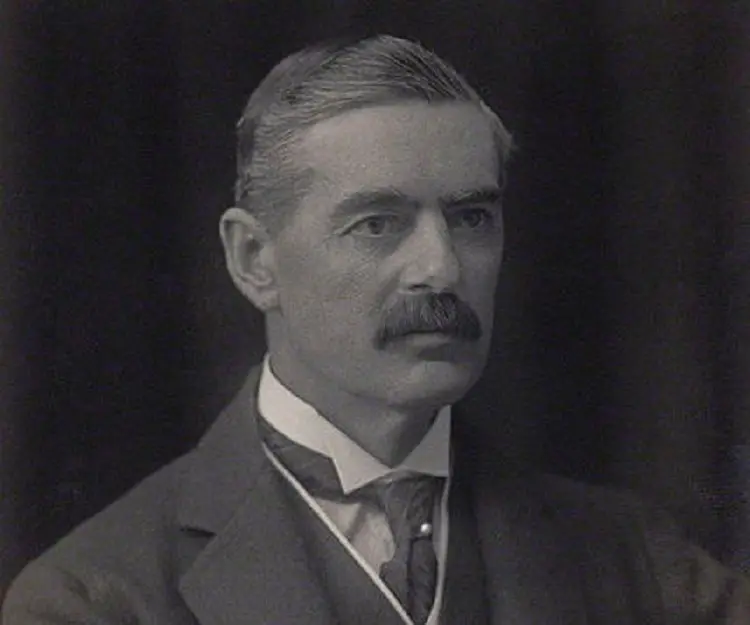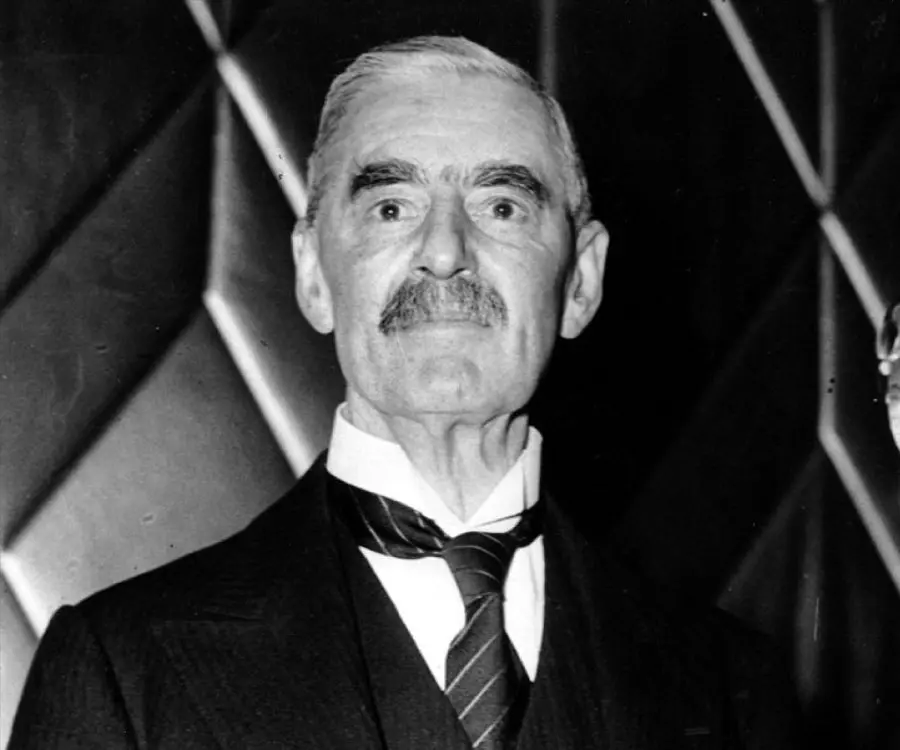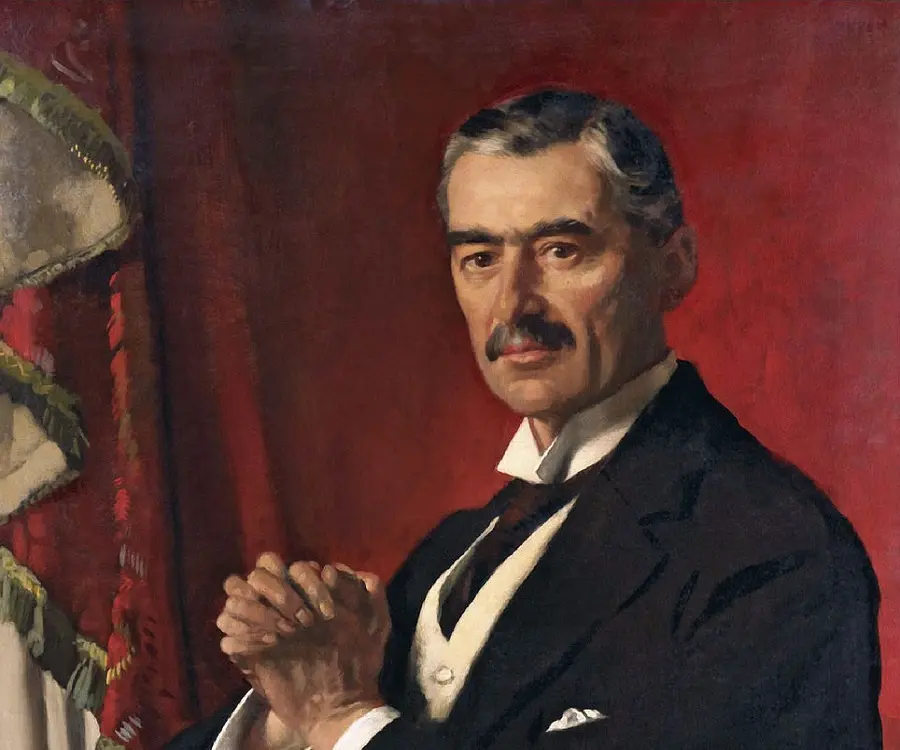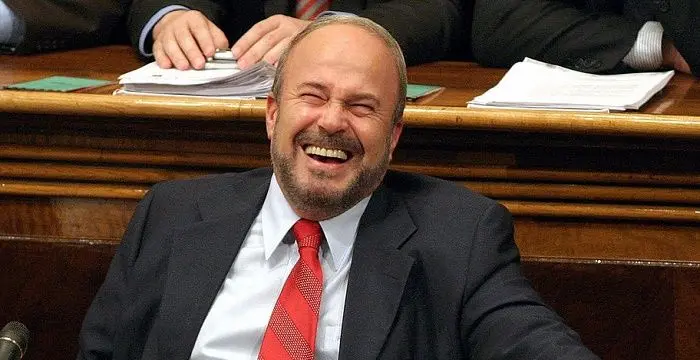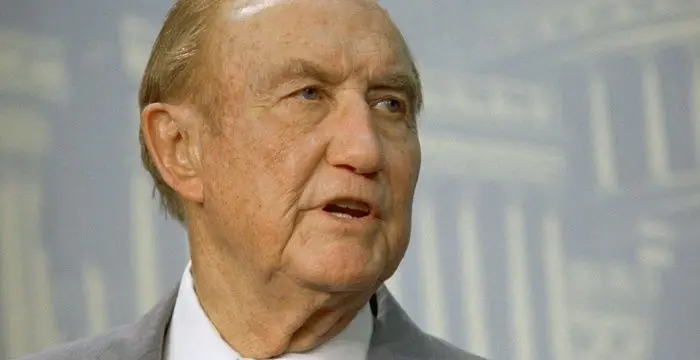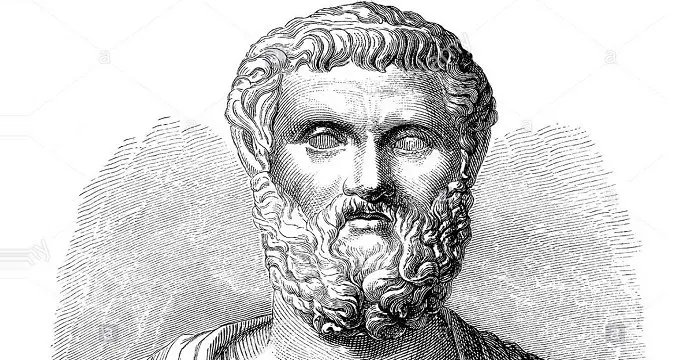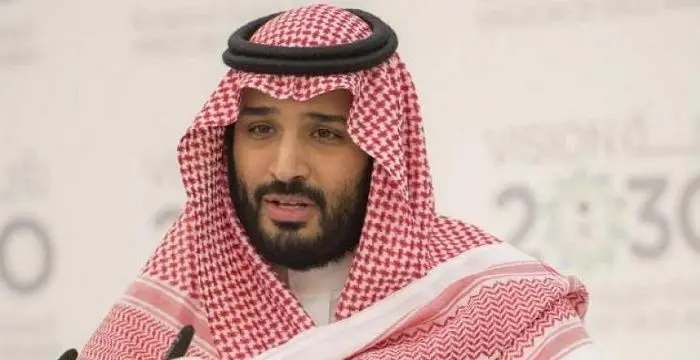
Neville Chamberlain - Prime Minister of the U.k, Timeline and Childhood
Neville Chamberlain's Personal Details
Neville Chamberlain was a British Prime Minister from 1937 until 1940, best remembered for his policy of appeasement towards Hitler
| Information | Detail |
|---|---|
| Birthday | March 18, 1869 |
| Died on | November 9, 1940 |
| Nationality | British |
| Famous | Leaders, Political Leaders, Prime Ministers, Prime Minister of the U.k |
| Hobbies | Fishing, Birdwatching |
| Spouses | Anne Chamberlain |
| Siblings | Austen Chamberlain |
| Known as | Arthur Neville Chamberlain, FRS |
| Childrens | Dorothy Chamberlain, Francis Chamberlain |
| Universities |
|
| Birth Place | Birmingham |
| Religion | Unitarianism |
| Height | 188 |
| Gender | Male |
| Father | Joseph Chamberlain |
| Mother | Florence Kenrick |
| Sun Sign | Pisces |
| Born in | Birmingham |
| Famous as | Prime Minister of the U.K. |
| Died at Age | 71 |
Neville Chamberlain's photo
Who is Neville Chamberlain?
Neville Chamberlain was a British politician who served as the country’s Prime Minister from 1937 until 1940. Born in a political family, Neville’s advent into politics was certain. However, unlike his father and half-brother, Chamberlain entered politics quite late in life. It was only at the age of 49 that he ventured into politics as the Member of Parliament, thus becoming the oldest Parliamentary debutant. Funnily, he holds the designation till date. What is interesting to note in Chamberlain’s early career is that until 1922 he chose to remain a backbencher, rejecting offers of junior ministerial position. However, fate turned in his favour in 1923 when he was promoted first as the Minister of Health and later to the office of the Chancellor of Exchequer. In 1937, he became the Prime Minister of United Kingdom. Though he brought forth a number of successful domestic policies, his premiership is best remembered for his appeasement foreign policy, including signing of the Munich Agreement in 1938 and conceding the German-speaking Sudetenland region of Czechoslovakia to Germany. Chamberlain was succeeded by his foremost critic and first Lord of Admiralty of his war cabinet, Winston Churchill
// Famous Prime Ministers
Edi Rama
Edi Rama is the current Prime Minister of Albania. Check out this biography to know about his childhood, life, achievements, works & timeline.
Leo Varadkar
Cam Leo Varadkar is the current Taoiseach—the Prime Minister—of the Republic of Ireland. Check out this biography to know about his childhood, family life, achievements and other facts about his life.
Fatos Nano
Fatos Nano is an Albanian politician who served as Prime Minister of Albania for several times. Check out this biography to know about his childhood, life, achievements, works & timeline.
Childhood & Early Life
Neville Chamberlain was born on March 18, 1869 to Joseph Chamberlain and Florence Kenrick. He had a half-brother Austen Chamberlain from his father’s first marriage.
Chamberlain attained much of his early education from Rugby School. Completing preliminary studies, he moved to Mason College (University of Birmingham). However, his lack of interest in academics soon led him to apprentice in a firm of accountants.
Career
Chamberlain established his career in mainstream business with the purchase of Hoskins & Company, a manufacturer of metal ship berths. He served as the managing director of the company for 17 years.
In 1906, he was appointed as the Governor of Birmingham's General Hospital and immediately thereafter became a founding member of National United Hospitals Committee of the British Medical Association
Chamberlain’s first stint in politics was as an avid supporter of his father’s Liberal Unionists. His first public office was as the chairman of the Town Planning Committee. It was under his administration that Britain adopted its first town planning schemes though the plan essentially remained on paper due to World War I.
In 1915, he took up the position of Lord Mayor of Birmingham during the tough phase of wartime. Same year, he was appointed as the member of the Central Control Board on liquor traffic.
In 1916, he served as the Director of National Service. However, due to lack of powers and support, he resigned from the office the following year.
Having gained enough experience in public office, he decided to stand as Unionist candidate for the House of Commons. Following the end of World War I, he was elected as a Unionist member with 70% votes.
From 1919 to 1921, he served as the chairman of the National Unhealthy Areas Committee and visited slums of England. During the 1922 election, Unionists left the coalition with Liberals and fought on their own with Bonar Law as their leader.
Under Bonar Law’s leadership, Unionists party faced opposition from high-ranking members within the party. This gave Chamberlain the opportunity to rise up the ladder. Within a span of ten months, he was promoted as Chancellor of the Exchequer.
In the 1923 general elections, the Conservative Party lost to the Labour Party and Charmberlain lost his position as the Chancellor of the Exchequer. In fact he barely managed to retain his parliamentary seat. But, within a few months, the Labour government fell necessitating another election. Chamberlain shifted his parliamentary seat from Ladywood to the much safer seat of Birmingham Edgbaston. After the Unionists victory, he became as the Minister of Health.
In 1929, he presented the Cabinet with 25 bills of which 21 were enacted upon and became a law. Briefly he left the office of the Minister of Health but resumed his duties after the fall of the Labour government.
During the 1931 general election, MacDonald’s National Government party comprising of mostly the Conservatives won overwhelmingly. Chamberlain was yet again offered the office of the Chancellor of the Exchequer.
During his second term in office as the Chancellor, his policies raised his reputation as an efficient administrator. He presented his first budget in April 1932. He not just reduced the interest rate on Britain’s war debt but successfully declared a budget surplus by 1934, thus restoring cuts in unemployment compensation and civil servant salaries
In 1937, he succeeded Stanley Baldwin as the Prime Minister, thus becoming the second-eldest person in the 20th century to become Prime Minister for the first time.
Immediately after being sworn as the PM, he passed the Factories Act of 1937, which laid emphasis on better working conditions and limited working hours for women and children. His other policies on domestic front included nationalization of coal deposits, clearance of slums, rent control and a week of paid holiday for workers by employers
During his reign, strained relations with Ireland that had been a cause of concern for his predecessors was rightfully resolved. Despite being tough negotiators, Irish finally conceded to pay Britain the money due. However, Britain had to compromise with the access of the three Treaty Ports excepting at the time of war. The issue of partition, however, was not resolved.
Having lived through World War I, Chamberlain was of the intention to avert a second war by all means. He tried to persuade Italy to move away from German influence and for the same even recognized Italian supremacy in Ethiopia. Furthermore, he kept Great Britain out of Spanish Civil War. However, these moves were condemned by Foreign Secretary Eden.
Chamberlain assumed that pacifying and appeasing Adolf Hitler was the only way to avert the dreaded war and its aftereffects. Due to the same, Munich Agreement was signed according to which Britain and France accepted that the Czech region of the Sudetenland should be ceded to Germany.
Following Hitler’s annexation of the Czech lands of Bohemia and Moravia and later Prague, Slovakia and Poland, Chamberlain accelerated British rearmament program and rejected further appeasement of any sort. With Poland attacked, Chamberlain responded with a British declaration of war on Germany on September 3, 1939.
He set up a war cabinet, inviting members of the Labour and Liberal Party. He even assigned Winston Churchill, his foremost critic, as the First Lord of the Admiralty. However, the war declared by British was a phoney one, as sporadic military action dominated the confrontation
Following the failure of a British expedition to Norway in April 1940 and his poor relations with the Labour Party, Chamberlain lost the support from many Conservatives members in the House of Commons. Resultantly, he resigned on May 10, 1940, the day of the German invasion of the Low Countries.
Following his resignation, Winston Churchill emerged as the new Prime Minister of Britain. Under Churchill’s coalition government, Chamberlain served loyally as Lord President of the Council. Additionally, he was also the leader of the Conservative Party. Chamberlain resigned from both the positions on September 30, 1940
Major Works
Chamberlain is best remembered for his the policy of appeasement towards Adolf Hitler in the period preceding World War II. It was due to this policy that he signed the Munich Agreement in 1938 and conceded the German-speaking Sudetenland region of Czechoslovakia to Germany. He has been blamed for Hitler’s rising aggression that needed to be nipped right at the start. Furthermore, he was held responsible in failing to prepare Britain for impending World War II.
Awards & Achievements
In 1938, Neville Chamberlain was made Fellow of the Royal Society.
In his lifetime, he was bestowed with Doctor of Civil Law by Oxford University. He was awarded LLB from Cambridge, Birmingham, Leeds, Bristol and Reading University.
He was conferred with two titles, Honorary Freedom City of Birmingham and Honoray Freedom City of London. The latter was received by his wife in 1941.
Personal Life & Legacy
Neville Chamberlain married Anne Cole in 1911. The couple was blessed with a son and a daughter.
He suffered from ill health during the latter half of 1940. His health worsened with time. Eventually on November 9, 1940, he passed away due to bowel cancer. His funeral service was held at Westminster Abbey and his ashes were interred next to Andrew Bonar Law.
Trivia
At age 49, he is still the oldest Parliamentary debutant (House of Commons) to later become Prime Minister of the United Kingdom.
// Famous Leaders
Edi Rama
Edi Rama is the current Prime Minister of Albania. Check out this biography to know about his childhood, life, achievements, works & timeline.
Tecumseh
Tecumseh was a Native American leader of the Shawnee clan. This biography profiles his childhood, life and timeline.
Khalifa bin Zayed Al Nahyan
Sheikh Khalifa bin Zayed Al Nahyan is the current President of the United Arab Emirates (UAE). Check out this biography to know about his birthday, childhood, family life, achievements and fun facts about him.
Neville Chamberlain's awards
| Year | Name | Award |
|---|---|---|
Other | ||
| 0 | Political party - Conservative | |
Neville Chamberlain biography timelines
- // 18th Mar 1869Neville Chamberlain was born on March 18, 1869 to Joseph Chamberlain and Florence Kenrick. He had a half-brother Austen Chamberlain from his father’s first marriage.
- // 1906In 1906, he was appointed as the Governor of Birmingham's General Hospital and immediately thereafter became a founding member of National United Hospitals Committee of the British Medical Association
- // 1911Neville Chamberlain married Anne Cole in 1911. The couple was blessed with a son and a daughter.
- // 1915In 1915, he took up the position of Lord Mayor of Birmingham during the tough phase of wartime. Same year, he was appointed as the member of the Central Control Board on liquor traffic.
- // 1916In 1916, he served as the Director of National Service. However, due to lack of powers and support, he resigned from the office the following year.
- // 1919 To 1922From 1919 to 1921, he served as the chairman of the National Unhealthy Areas Committee and visited slums of England. During the 1922 election, Unionists left the coalition with Liberals and fought on their own with Bonar Law as their leader.
- // 1923In the 1923 general elections, the Conservative Party lost to the Labour Party and Charmberlain lost his position as the Chancellor of the Exchequer. In fact he barely managed to retain his parliamentary seat. But, within a few months, the Labour government fell necessitating another election. Chamberlain shifted his parliamentary seat from Ladywood to the much safer seat of Birmingham Edgbaston. After the Unionists victory, he became as the Minister of Health.
- // 1929In 1929, he presented the Cabinet with 25 bills of which 21 were enacted upon and became a law. Briefly he left the office of the Minister of Health but resumed his duties after the fall of the Labour government.
- // 1931During the 1931 general election, MacDonald’s National Government party comprising of mostly the Conservatives won overwhelmingly. Chamberlain was yet again offered the office of the Chancellor of the Exchequer.
- // Apr 1932 To 1934During his second term in office as the Chancellor, his policies raised his reputation as an efficient administrator. He presented his first budget in April 1932. He not just reduced the interest rate on Britain’s war debt but successfully declared a budget surplus by 1934, thus restoring cuts in unemployment compensation and civil servant salaries
- // 1937In 1937, he succeeded Stanley Baldwin as the Prime Minister, thus becoming the second-eldest person in the 20th century to become Prime Minister for the first time.
- // 1937Immediately after being sworn as the PM, he passed the Factories Act of 1937, which laid emphasis on better working conditions and limited working hours for women and children. His other policies on domestic front included nationalization of coal deposits, clearance of slums, rent control and a week of paid holiday for workers by employers
- // 1938Chamberlain is best remembered for his the policy of appeasement towards Adolf Hitler in the period preceding World War II. It was due to this policy that he signed the Munich Agreement in 1938 and conceded the German-speaking Sudetenland region of Czechoslovakia to Germany. He has been blamed for Hitler’s rising aggression that needed to be nipped right at the start. Furthermore, he was held responsible in failing to prepare Britain for impending World War II.
- // 1938In 1938, Neville Chamberlain was made Fellow of the Royal Society.
- // 3rd Sep 1939Following Hitler’s annexation of the Czech lands of Bohemia and Moravia and later Prague, Slovakia and Poland, Chamberlain accelerated British rearmament program and rejected further appeasement of any sort. With Poland attacked, Chamberlain responded with a British declaration of war on Germany on September 3, 1939.
- // 10th May 1940Following the failure of a British expedition to Norway in April 1940 and his poor relations with the Labour Party, Chamberlain lost the support from many Conservatives members in the House of Commons. Resultantly, he resigned on May 10, 1940, the day of the German invasion of the Low Countries.
- // 30th Sep 1940Following his resignation, Winston Churchill emerged as the new Prime Minister of Britain. Under Churchill’s coalition government, Chamberlain served loyally as Lord President of the Council. Additionally, he was also the leader of the Conservative Party. Chamberlain resigned from both the positions on September 30, 1940
- // 9th Nov 1940He suffered from ill health during the latter half of 1940. His health worsened with time. Eventually on November 9, 1940, he passed away due to bowel cancer. His funeral service was held at Westminster Abbey and his ashes were interred next to Andrew Bonar Law.
// Famous Political Leaders
Edi Rama
Edi Rama is the current Prime Minister of Albania. Check out this biography to know about his childhood, life, achievements, works & timeline.
Khalifa bin Zayed Al Nahyan
Sheikh Khalifa bin Zayed Al Nahyan is the current President of the United Arab Emirates (UAE). Check out this biography to know about his birthday, childhood, family life, achievements and fun facts about him.
Leo Varadkar
Cam Leo Varadkar is the current Taoiseach—the Prime Minister—of the Republic of Ireland. Check out this biography to know about his childhood, family life, achievements and other facts about his life.
Strom Thurmond
Strom Thurmond was an American politician, who represented the state of South Carolina in the United States senate for 48 years.
Solon
Solon was an Athenian lawmaker, poet and politician. He is considered as one of the ‘Seven Wise Men’ in Greek culture. This biography provides detailed information about his childhood, life, career, works, achievements and timeline.
Mohammed bin Salman
Mohammed bin Salman is the Crown Prince of Saudi Arabia and the heir apparent to the throne. Check out this biography to know about his childhood, family life, achievements and other facts about him.
Neville Chamberlain's FAQ
What is Neville Chamberlain birthday?
Neville Chamberlain was born at 1869-03-18
When was Neville Chamberlain died?
Neville Chamberlain was died at 1940-11-09
Where was Neville Chamberlain died?
Neville Chamberlain was died in Heckfield
Which age was Neville Chamberlain died?
Neville Chamberlain was died at age 71
Where is Neville Chamberlain's birth place?
Neville Chamberlain was born in Birmingham
What is Neville Chamberlain nationalities?
Neville Chamberlain's nationalities is British
What is Neville Chamberlain hobbies?
Neville Chamberlain's hobbies is Fishing, Birdwatching
Who is Neville Chamberlain spouses?
Neville Chamberlain's spouses is Anne Chamberlain
Who is Neville Chamberlain siblings?
Neville Chamberlain's siblings is Austen Chamberlain
Who is Neville Chamberlain childrens?
Neville Chamberlain's childrens is Dorothy Chamberlain, Francis Chamberlain
What was Neville Chamberlain universities?
Neville Chamberlain studied at Rugby School, Mason Science College
What is Neville Chamberlain's religion?
Neville Chamberlain's religion is Unitarianism
How tall is Neville Chamberlain?
Neville Chamberlain's height is 188
Who is Neville Chamberlain's father?
Neville Chamberlain's father is Joseph Chamberlain
Who is Neville Chamberlain's mother?
Neville Chamberlain's mother is Florence Kenrick
What is Neville Chamberlain's sun sign?
Neville Chamberlain is Pisces
How famous is Neville Chamberlain?
Neville Chamberlain is famouse as Prime Minister of the U.K.
